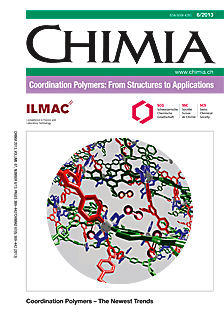A Journey from Supramolecular Chemistry to Nanoscale Networks
DOI:
https://doi.org/10.2533/chimia.2013.388Keywords:
Coordination polymers, Functional materials, Ligand designAbstract
The use of the coordination properties of metal centres to organise organic ligands in space is a concept that dates back to the seminal work of Alfred Werner that was recognised by the award of the first Nobel Proze for Chemistry in inorganic chemistry 100 years ago. Metal ions may be used to control the assembly of one-, two- or three-dimensional structures by matching the coordination number and geometry with the number and arrangement of donor atoms within ligands. These so-called coordination polymers have recently emerged from the category of unwanted insoluble side-products to materials of high scietrific interest and economic potential. This short article presents the simple design principles that lie behind the synthesis of materials possessing useful properties and, often stunningly attractive structural motifs.Downloads
Published
2013-06-26
Issue
Section
Scientific Articles
License
Copyright (c) 2013 Swiss Chemical Society

This work is licensed under a Creative Commons Attribution-NonCommercial 4.0 International License.
How to Cite
[1]
E. C. Constable, Chimia 2013, 67, 388, DOI: 10.2533/chimia.2013.388.







